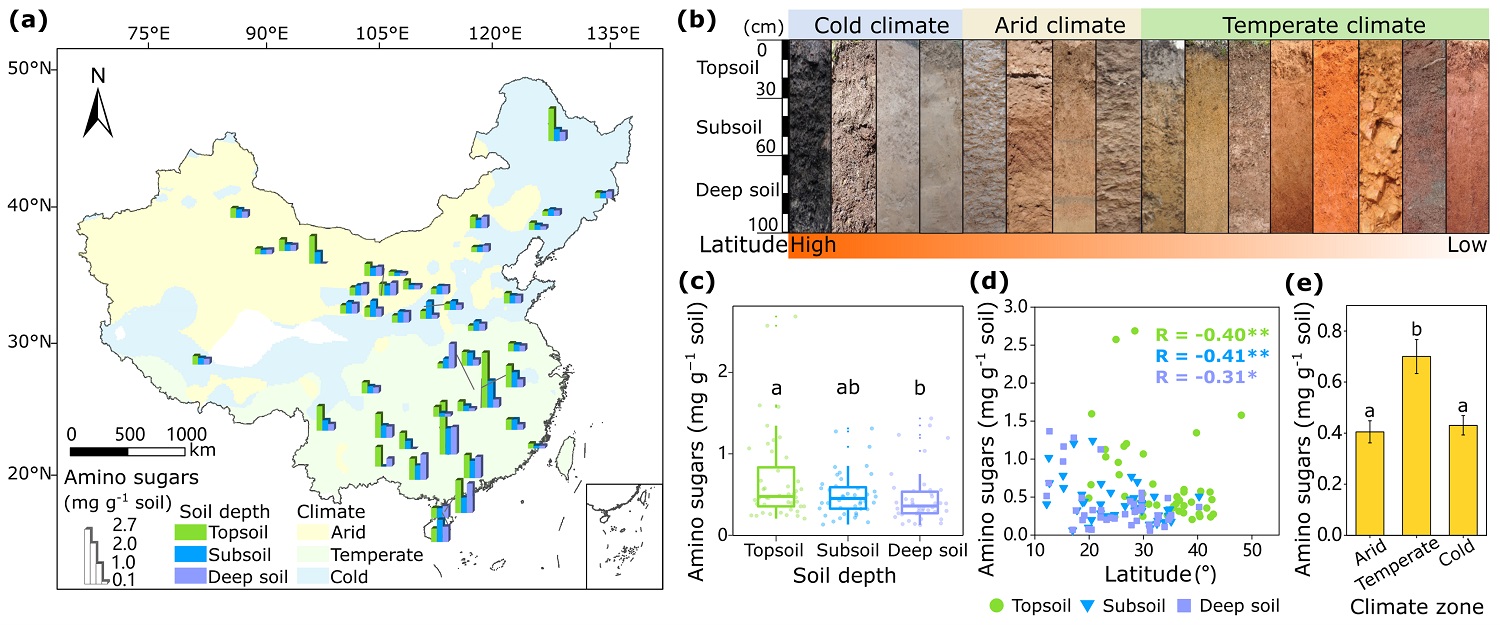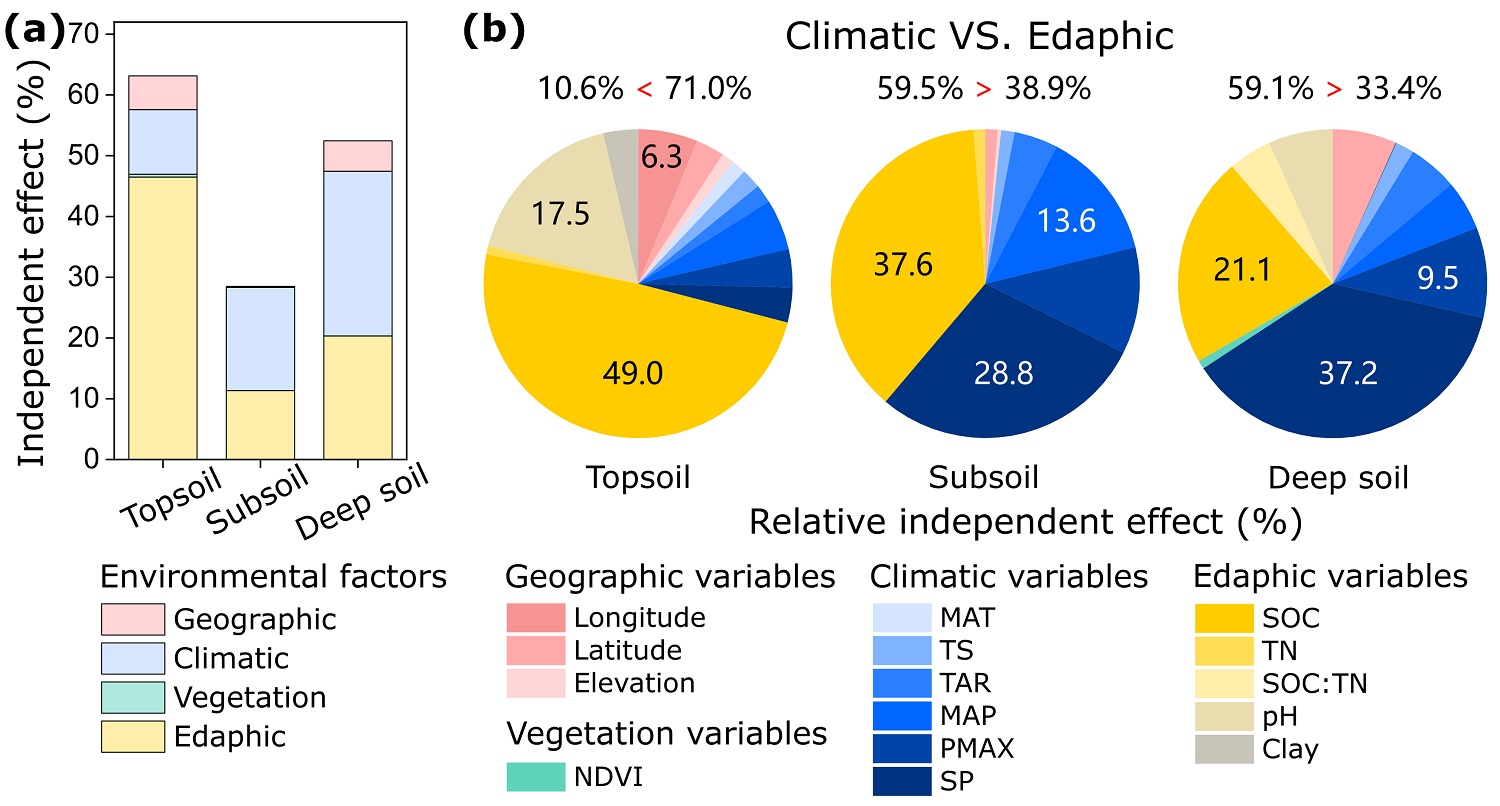核心提示: 近日,我校农业微生物资源发掘与利用全国重点实验室、资源与环境学院在土壤剖面微生物残体碳积累方面取得新进展,相关成果以“Climatic seasonality challenges the stability of microbial-driven deep soil carbon accumulation across China”发表在Global Change Biology。
南湖新闻网讯(通讯员 张文)近日,我校农业微生物资源发掘与利用全国重点实验室、资源与环境学院在土壤剖面微生物残体碳积累方面取得新进展,相关成果以“Climatic seasonality challenges the stability of microbial-driven deep soil carbon accumulation across China”为题发表于Global Change Biology。该论文报道了微生物残体碳在土壤剖面上的地理空间分布特征,揭示了气候季节性是深层土壤微生物残体碳积累的主控因子。
深层土壤是巨大的碳库,有50%以上的土壤有机碳储存于深层土壤。微生物残体碳作为稳定有机碳库的重要组成,对调节全球气候起到关键作用。然而,尽管众多研究阐明了表层微生物残体碳的分布及其主控因子,但微生物残体碳在土壤剖面(尤其深层土壤)上的积累及其对气候变化的敏感程度仍不清楚。本研究在全国44个样点采集了129个0-1m土壤剖面样品,通过测定氨基糖含量探究了微生物残体碳在土壤剖面上的分布特征及影响因素。研究结果表明,深层(60-100 cm)土壤的微生物残体占土壤有机碳的比例高于浅层(0-30和30-60 cm)土壤,表明了微生物来源碳在深层土壤碳库中的重要地位。此外,土壤剖面微生物残体碳含量随纬度增加而减少,且在不同气候带中表现强地理空间变异性。

图片1 土壤剖面微生物残体的地理空间分布格局
本研究综合考虑地理、气候、土壤属性等环境因子分析发现,深层土壤微生物残体积累主要受气候的影响,而表层土壤微生物残体积累受土壤性质和气候的共同调控。气候季节性,包括夏季降水、最大月降水量、温度季节性、年温差等是解释大尺度深层土壤微生物残体积累的重要因子。其中,夏季降水是深层土壤微生物来源碳稳定性的关键调节因子,其相对独立影响占37.2%。此外,气候季节性在深层土壤中与细菌残体碳有更强的关联,但在表层土壤中与真菌残体碳有更强的关联。综上,本研究强调了气候季节性对深层土壤微生物残体碳的重要影响,并认为当今气候变化可能挑战深层碳库的稳定固存。

图片2 土壤剖面微生物残体的影响因子
华中农业大学资源与环境学院博士后文书海和陈家赢副教授为论文共同第一作者,刘玉荣教授为通讯作者。美国奥克兰大学Ziming Yang教授、西北农林科技大学邓蕾研究员、西班牙国家研究委员会自然资源和农业生物学研究所Manuel Delgado-Baquerizo教授、华中农业大学黄巧云教授、冯娇副研究员及研究生曾晓敏、张文等也参与了该项研究。本研究得到了国家自然科学基金和华中农业大学人才项目资助。
英文摘要
Microbial residues contribute to the long-term stabilization of carbon in the entire soil profile, helping to regulate the climate of the planet; however, how sensitive these residues are to climatic seasonality remains virtually unknown, especially for deep soils across environmental gradients. Here, we investigated the changes of microbial residues along soil profiles (0–100 cm) from 44 typical ecosystems with a wide range of climates (~3100 km transects across China). Our results showed that microbial residues account for a larger portion of soil carbon in deeper (60–100 cm) vs. shallower (0–30 and 30–60 cm) soils. Moreover, we find that climate especially challenges the accumulation of microbial residues in deep soils, while soil properties and climate share their roles in controlling the residue accumulation in surface soils. Climatic seasonality, including positive correlations with summer precipitation and maximum monthly precipitation, as well as negative correlations with temperature annual range, are important factors explaining microbial residue accumulation in deep soils across China. In particular, summer precipitation is the key regulator of microbial-driven carbon stability in deep soils, which has 37.2% of relative independent effects on deep-soil microbial residue accumulation. Our work provides novel insights into the importance of climatic seasonality in driving the stabilization of microbial residues in deep soils, challenging the idea that deep soils as long-term carbon reservoirs can buffer climate change.
论文链接:https://onlinelibrary.wiley.com/doi/10.1111/gcb.16760
审核人 刘玉荣
